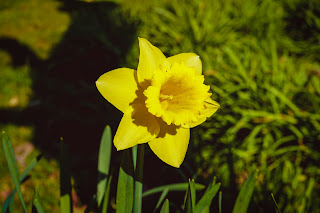Finishing the Daffodil
Painting flowers is a lot like acting on a stage. In order for people to see you from a distance, you need overdone make-up; you have to emote when speaking; you have to create the drama. When you paint flowers, you can't be afraid to make strong colors and contrasts to get your message across. So when I use purple to shade a yellow flower, that is what I am doing--
Working in negative painting
Make a dark green (I used Pthalo and quin gold) in a fairly thick mixture. If it is too watery, the value will never get dark enough to make a black.
Use this dark green to paint behind all the petals and leaves. I want the top and right side to gradually get lighter, so I am wetting that area more and letting the green mix become weaker in those spots. Let the water do the work. Dry this all completely. You need to be sure you are getting a dark green color.
Next make a dark red orange, in a heavier mixture. Paint this orange over all the dark greens and places you want to be black. In the picture below, you can see how where I have painted the orange has become dark brown. I left a little green at the bottom so you can compare. Dry all the paint. (In place of orange, you can use burnt sienna with a bit of red in it)
Next make a dark violet mixture. Paint over all the areas you want to be black. I've painted the left hand spaces with violet, left one space with just green and orange, and the right spaces with just green so you can see the progression.
The order of placing the colors can be switched up. You can even use primary colors instead of secondary colors. I just like using secondaries better.
Finishing the petals
When you are satisfied with the background, remove all the masking.
(I use a rubber cement eraser, very inexpensive, but you can use your clean fingers or masking tape rolled around a finger )
To be honest, I don't love using masking. I could have painted the flower first and then masked off the edges to protect them from the darker layers of paint. Masking can leave some very hard edges and look contrived.
With a small brush, paint in some yellows over the frills. If you have lost some of the shadows, make a watery violet, (or raw sienna) and paint over some of the shadows. Use this to create some shadows in the frills too. You can paint some fine lines for veins. In the trumpet of the flower, be sure that the veins curve with the shape of the petals, always radiating from the center.
Use the shadows to create a hard edge separating the petals, so they stand out more. Apply your paint where you want it darkest, and then spread it out with clean water so you have no hard edges in the shadow.
Here I've removed masking and started to add some shadows in the frills. I've also darkened the shadows between petals.
Here I've added a few veins in the trumpet. I will also lift a little on the frilly edge of the trumpet.

For the white flower, use your cobalt blue to darken the center. Water it down a bit to add light shadows in the frilly part of the trumpet.
To separate leaves, decide which leaf is forward and which is behind. The forward one casts a shadow on the one behind it. Where the two meet, darken the behind leaf to make a cast shadow, hard edges where the two meet, and softened on the behind leaf. Do this on each side where the two leaves/stems meet.
The final step is "lifting" with a stiffer brush. Please don't use your good brushes to lift. Find an inexpensive, stiffer brush (see the prior blog for suggestions) so you don't wear out your good tips.
Generally I use lifting for three things: 1, to soften a hard edge (like the Miskit); 2, to clean up edges and mistakes; 3, to lift a highlight to softly round an area. (like in this yellow bud)
I also use it, as in the picture below, to "lift out" a few distant leaves just with a brush and some water. (See the very dark but softened leaves in the background) You can't get this effect unless you paint your darks in layers.
There is a brownish papery covering over daffodil stems near the flower. I just lifted a little and used some burnt umber, watered down over the area. I used dark brown for the tiny area at the top of this.
I still have to finish the darks and clean up some edges, but it might look similar to this.
Daffodils are gorgeous, and there are so many right ways to do it, both loose and tight.
I chose this way to teach about using underpainting to get in believable shadows, and to teach how to get rich darks in a background.






























